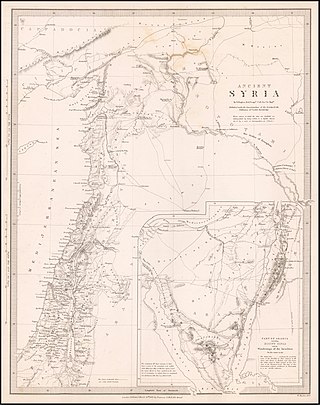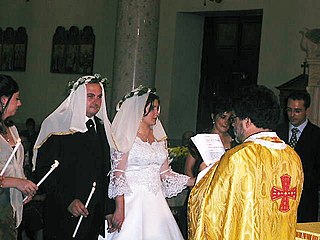Related Research Articles

Ephrem the Syrian, also known as Saint Ephrem, Saint Ephraim, Ephrem of Edessa or Aprem of Nisibis, was a prominent Christian theologian and writer, who is revered as one of the most notable hymnographers of Eastern Christianity. He was born in Nisibis, served as a deacon and later lived in Edessa.
The Syriac language, also known as Syriac Aramaic and Classical Syriac ܠܫܢܐ ܥܬܝܩܐ, is an Aramaic dialect that emerged during the first century AD from a local Aramaic dialect that was spoken in the ancient region of Osroene, centered in the city of Edessa. During the Early Christian period, it became the main literary language of various Aramaic-speaking Christian communities in the historical region of Ancient Syria and throughout the Near East. As a liturgical language of Syriac Christianity, it gained a prominent role among Eastern Christian communities that used both Eastern Syriac and Western Syriac rites. Following the spread of Syriac Christianity, it also became a liturgical language of eastern Christian communities as far as India and China. It flourished from the 4th to the 8th century, and continued to have an important role during the next centuries, but by the end of the Middle Ages it was gradually reduced to liturgical use, since the role of vernacular language among its native speakers was overtaken by several emerging Neo-Aramaic dialects.

The Syriac Orthodox Church, also known as West Syriac Church or West Syrian Church, officially known as the Syriac Orthodox Patriarchate of Antioch and All the East, and informally as the Jacobite Church, is an Oriental Orthodox church that branched from the Church of Antioch. The bishop of Antioch, known as the patriarch, heads the church and possesses apostolic succession through Saint Peter, according to sacred tradition. The church upholds Miaphysite doctrine in Christology, and employs the Divine Liturgy of Saint James, associated with James, the brother of Jesus. Classical Syriac is the official and liturgical language of the church.
The Arameans, or Aramaeans, were an ancient Semitic-speaking people in the Near East that was first recorded in historical sources from the late 12th century BC. The Aramean homeland, sometimes known as the land of Aram, encompassed central regions of modern Syria.

Syriac Christianity is a distinctive branch of Eastern Christianity whose formative theological writings and traditional liturgies are expressed in the Classical Syriac language, a variation of the old Aramaic language. In a wider sense, the term can also refer to Aramaic Christianity in general, thus encompassing all Christian traditions that are based on liturgical uses of Aramaic language and its variations, both historical and modern.

The Liturgy of Saint James is a form of Christian liturgy used by some Eastern Christians of the Byzantine rite and West Syriac Rite. It is developed from an ancient Egyptian form of the Basilean anaphoric family, and is influenced by the traditions of the rite of the Church of Jerusalem, as the Mystagogic Catecheses of Cyril of Jerusalem imply. It became widespread in Church of Antioch from the fourth or fifth century onwards, replacing the older Basilean Liturgy of Antioch. It is still the principal liturgy of the Syriac Orthodox Church, the Malankara Orthodox Syrian Church, the Maronite Church, the Syriac Catholic Church, Syro-Malankara Catholic Church and other churches employing the West Syriac Rite. It is also occasionally used in the Eastern Orthodox Church and Melkite Catholic Church. The Malankara Mar Thoma Syrian Church uses a reformed variant of this liturgy, omitting intercession of saints and prayer for the dead.
Jacob of Edessa was Bishop of Edessa and prominent Syriac Christian writer in Classical Syriac language, also known as one of earliest Syriac grammarians. In various works, he treated theological, liturgical, canonical, philosophical and historical subjects, and contributed significantly to scholarly and literary development of Syriac Christianity. He is considered to be one of the most important scholars of the Christian-Aramean tradition.
Syriac sacral music is music in the Syriac language as used in the liturgy of Syriac Christianity. Historically it is best known from and important for its part in the development of Christian sacred music since Antiquity.
Beth Nahrain ; "between (two) rivers") is the name for the region known as Mesopotamia in the Syriac language. Geographically, it refers to the areas between and surrounding the Euphrates and Tigris rivers. The Aramaic name also refers to the area around the rivers, not only literally between the rivers. The area is considered by Assyrians as their homeland.

Syrian chant is one of the oldest Christian chants in the world. Due to the lack of information concerning early musical manuscripts, it is conjectural to what extent the modern repertoire reflects the early traditions. What we know of the sound in Syrian chant is mainly derived from modern performances. Modern performances have a sparse texture and are highly ornamented. The setting within which Syriac chant takes place is, also only understood through the modern performances of Syriac chant. The chant seems to be designed to resonate throughout the building it is performed in. This suggests that the setting was always a church building or a room that reflected the sound of the walls and ceilings. There is some difficulty in studying Syrian chant due to the geopolitical conflict throughout Syrian Christian history. Many of the conflicts have resulted in persecution of Syrian Christians which may account for the oral tradition of Syriac chant. The history of Syriac chant is derived from diaspora and persecution.

Moran Mor Ignatius Jacob (Yaʿqub) III was the 121st Syriac Orthodox Patriarch of Antioch and head of the Syriac Orthodox Church 1957-1980. He was skilled in and knowledgeable in Syriac sacral music or Beth Gazo. He re-established the Maphrianate/Catholicate in the Jacobite Syrian Orthodox Church.

The Midnight Office is one of the Canonical Hours that compose the cycle of daily worship in the Byzantine Rite. The office originated as a purely monastic devotion inspired by Psalm 118:62, At midnight I arose to give thanks unto Thee for the judgments of Thy righteousness (LXX), and also by the Gospel Parable of the Wise and Foolish Virgins.
The Octoechos is a liturgical book containing a repertoire of hymns ordered in eight parts according to eight echoi. Originally created in the Monastery of Stoudios during the 9th century as a hymnal complete with musical notation, it is still used in many rites of Eastern Christianity. The book with similar function in the Western Church is the tonary, and both contain the melodic models of an octoechos system; however, while the tonary serves simply for a modal classification, the octoechos is organized as a cycle of eight weeks of services. The word itself can also refer to the repertoire of hymns sung during the celebrations of the Sunday Office.

A liturgical book, or service book, is a book published by the authority of a church body that contains the text and directions for the liturgy of its official religious services.
Only-Begotten Son, sometimes called "Justinian's Hymn", the "Anthem of Orthodoxy" and/or the "Hymn of the Incarnation", is an ancient Christian hymn that was composed prior to the middle of the 6th century. It is chanted at the end of the Second Antiphon during the Divine Liturgies of St John Chrysostom, St Basil the Great and of St Gregory the Illuminator, and at the Little Entrance during the Liturgy of Saint James.
Gazo may refer to:

Shehimo is the West Syriac Christian breviary of the Syriac Orthodox Church and the West Syriac Saint Thomas Christians of India that contains the seven canonical hours of prayer. The Shehimo includes Bible readings, hymns and other prescribed prayers from the West Syriac Liturgical system. Within the breviary there are certain prayers that are recited at seven fixed prayer times, while facing the east at home or at church. The Shehimo also provides communal prayers as an introduction to the Holy Qurbono. The practice of praying during the canonical hours has its roots taken from Psalm 119:164, in which the prophet David prays to God seven times a day. The Shehimo breviary can be prayed either by reading or chanting the prose or singing the verses. The different versions of the breviary are available in Syriac, Malayalam, English, among other languages.

The Holy Qurobo or Holy Qurbono refers to the Eucharist as celebrated in Syro-Antiochene Rite and the liturgical books containing rubrics for its celebration. West Syriac Rite includes various descendants of the Oriental Orthodox and Eastern Catholic churches. It consists of two distinct liturgical traditions: the Maronite Rite, and the Jacobite Rite. The major Anaphora of both the traditions is the Divine Liturgy of Saint James in Syriac language. The Churches are primarily based in the Middle East, Africa, and India.
Thomas Koonammakkal is a Syro-Malabar Catholic priest and syriacist, scholar and church historian. He is an expert in Karshoni Malayalam and is the author of the most comprehensive Karshoni Malayalam introduction to date. He has also authored several critical articles on Early Christianity and on the works of Saint Ephrem. He holds a master's degree in Syriac studies and a doctorate from the University of Oxford. He served as the professor of Syriac and Patrology in SEERI, Vadavathoor Saint Thomas Apostolic Seminary and Paurastya Vidyapitham. He is the founder of Beth Aprem Nazrani Dayara and is a strong advocate of traditionalism in the Syro-Malabar Church.

The Mystery of Crowning is a ritual component of the sacrament of marriage in Eastern Christianity. Variations of the crowning ceremony exist in multiple liturgical rites, including the Byzantine, Coptic, West Syriac, and East Syriac Rites of the Eastern Orthodox, Oriental Orthodox, and Eastern Catholic Churches. The crowning ceremony typically features a crown being placed upon the head of both the bride and bridegroom, crowning them as the queen and king of a new family.
References
- ↑ Edessian Preservation Initiative, lostorigins
- Gregorios Y. IBRAHIM, Ephrem's Madroshe and the Syrian Orthodox Beth Gazo: A Loose, But Fascinating, Affinity, Hugoye
- The Treasury of Chants, Hugoye
- History of The Syriac Music Church, Abrohom Lahdo and Elias Zazi